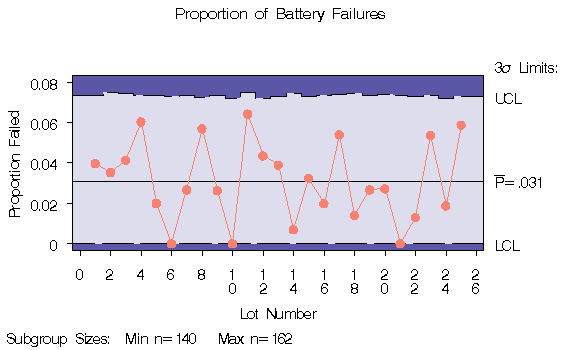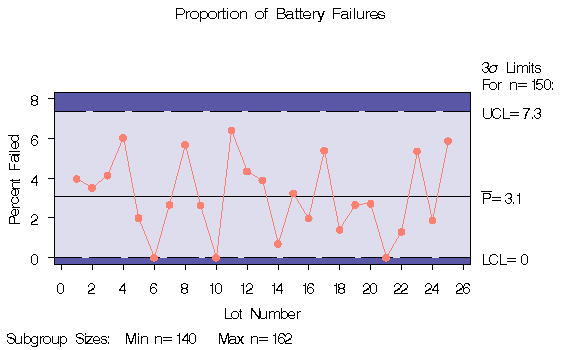Chapter Contents
Previous
Next
|
Chapter Contents |
Previous |
Next |
| PCHART Statement |
| See SHWPEX3 in the SAS/QC Sample Library |
The following statements create a SAS data set named BATTERY, which contains the number of alkaline batteries per lot failing an acceptance test. The number of batteries tested in each lot varies but is approximately 150.
data battery;
length lot $3;
input lot nfailed sampsize @@;;
label nfailed ='Number Failed'
lot ='Lot Identifier'
sampsize='Number Sampled';
datalines;
AE3 6 151 AE4 5 142 AE9 6 145
BR3 9 149 BR7 3 150 BR8 0 156
BR9 4 150 DB1 9 158 DB2 4 152
DB3 0 162 DB5 9 140 DB6 7 161
DS4 6 154 DS6 1 144 DS8 5 154
JG1 3 151 MC3 8 148 MC4 2 143
MK6 4 150 MM1 4 147 MM2 0 150
RT5 2 154 RT9 8 149 SP1 3 160
SP3 9 153
;
The variable NFAILED contains the number of battery failures, the variable LOT contains the lot number, and the variable SAMPSIZE contains the lot sample size. The following statements request a p chart for this data:
title 'Proportion of Battery Failures';
symbol v=dot c=salmon;
proc shewhart data=battery;
pchart nfailed*lot / subgroupn = sampsize
turnhlabels
outlimits = batlim
cframe = lib
cinfill = bwh
cconnect = salmon
coutfill = yellow ;
label nfailed = 'Proportion Failed';
run;
The chart is shown in Output 38.3.1 and the OUTLIMITS= data set BATLIM is listed in Output 38.3.2.
Output 38.3.1: A p Chart with Varying Subgroup Sample Sizes

|
|
The SHEWHART procedure provides various options for working with unequal subgroup sample sizes. For example, you can use the LIMITN= option to specify a fixed (nominal) sample size for computing the control limits, as illustrated by the following statements:
title 'Proportion of Battery Failures';
symbol v=dot c=salmon;
proc shewhart data=battery;
pchart nfailed*lot / subgroupn = sampsize
limitn = 150
alln
yscale = percent
cframe = lib
cinfill = bwh
coutfill = yellow
cconnect = salmon;
label nfailed = 'Percent Failed';
run;
The ALLN option specifies that all points (regardless of subgroup sample size) are to be displayed. By default, only points for subgroups whose sample size matches the LIMITN= value are displayed. The YSCALE= option specifies that the vertical axis is to be scaled in percentages rather than proportions. The chart is shown in Output 38.3.3.
Output 38.3.3: Control Limits Based on Fixed Subgroup Sample Size

|
|
Chapter Contents |
Previous |
Next |
Top |
Copyright © 1999 by SAS Institute Inc., Cary, NC, USA. All rights reserved.